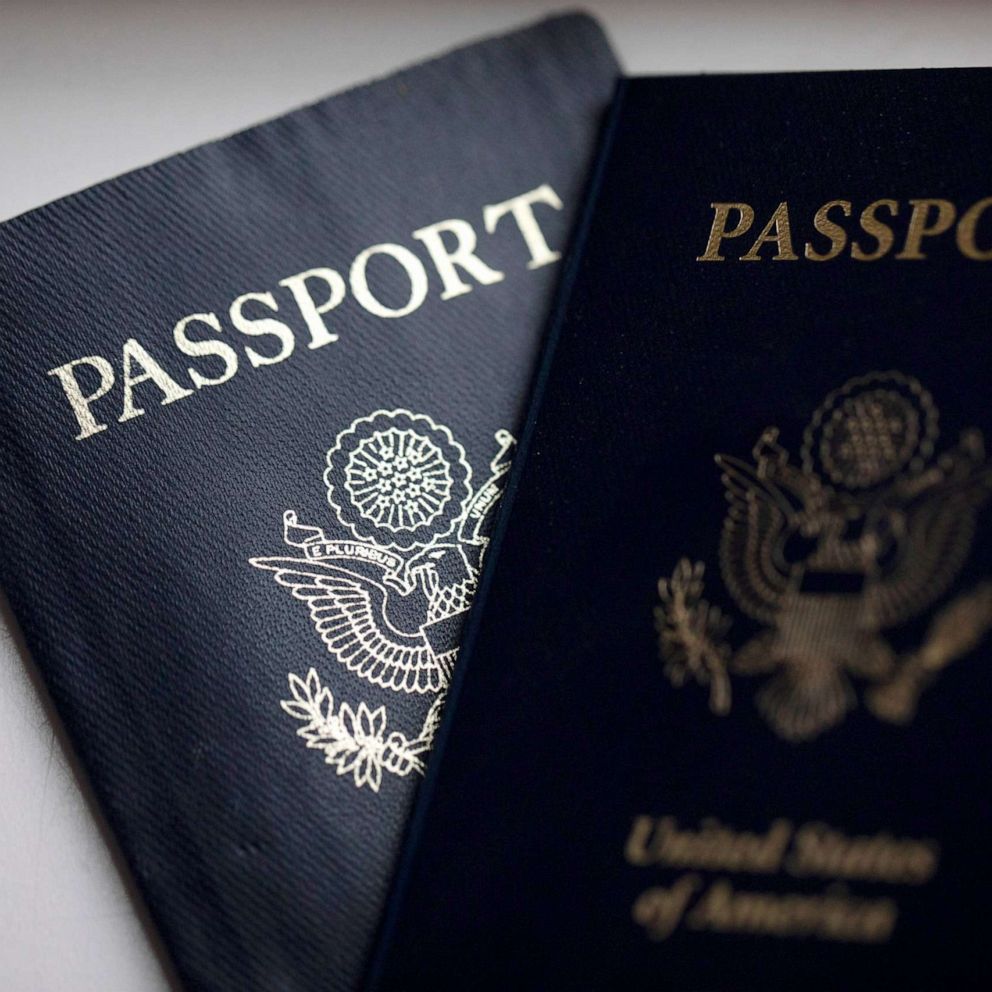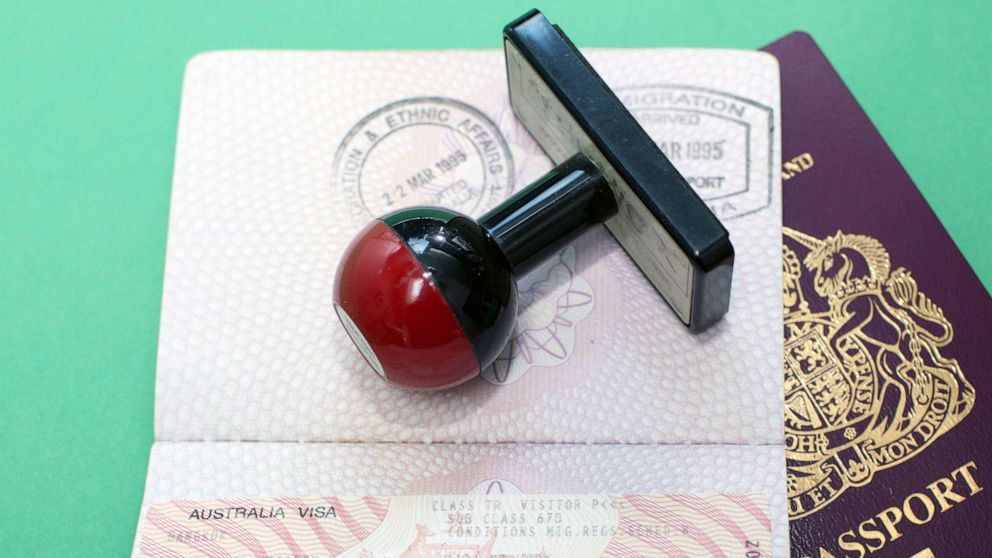New requirements for Americans traveling to Europe postponed until 2025
Visitors who now travel visa-free will need to get approval prior to departure.
Americans eyed upcoming travel to European destinations slightly differently due to news of a requirement that was set to start in 2024 for U.S. passport holders. But now, EU officials have postponed the European Travel Information and Authorisation System ( ETIAS ) launch until spring of 2025.
SchengenVisaInfo.com, a website dedicated to the world's largest visa-free zone where 27 European countries abolished their internal borders known as the Schengen Area, first reported that an EU official confirmed ETIAS won't go live until May 2025, "due to continued delays with the introduction of the related Entry-Exit System (EES), which needs to be operational before ETIAS can be implemented."
An official for the European Union did not immediately respond to ABC News' request for comment.

What to know about ETIAS for US travelers
If you previously traveled to Europe without a visa, you will now need to apply for authorization through the ETIAS , before visiting.

Today, American travelers have visa-free access to 184 global destinations, according to the Henley Passport Index . And while the U.S. passport is currently ranked eighth-most powerful passport to own, that could be set to shift when the European Union adds its new documentation requirements for U.S. visitors.
The application form, which will be available on the official ETIAS website as well as a mobile application, has a fee of 7 euros or $7.79 U.S. dollars. All communication is done by email.
Once you are approved for travel, the authorization entitles visitors to stay in European countries that require ETIAS for up to 90 days within any 180-day period and travelers must be in possession of a valid ETIAS during their entire stay.
MORE: New warning issued for rebooking air travel after delays, cancellations
According to ETIAS, most applications should be processed within minutes, but in case an application takes longer, decisions will be sent within four days or up to 14 days if the applicant is asked to provide additional documentation.
The European Union encourages travelers to apply for an ETIAS authorization "well in advance of your planned journey."
Confirmation of application submission will be sent on email with a unique number that is needed for future reference.

Upon receiving ETIAS travel authorization, travelers are to ensure that their name, passport number and other information is correct because any mistake will prevent them from crossing the border.
If an application is refused, the email will include the reasons for the decision along with information about how to appeal.
ETIAS travel authorization is valid for three years, according to the EU, or until the travel document you used in your application expires, whichever comes first.
MORE: European heat wave breaking records with little relief in sight
The ETIAS authorization is linked to a person's travel document -- such as a U.S. passport -- and both documents will be needed to board a flight, bus or ship to enter any of the European countries that require ETIAS.
Similar to international border requirements with a passport, the ETIAS authorization doesn't guarantee automatic right of entry. "Border guards will verify that you meet the entry conditions" and anyone who does not meet the conditions "will be refused entry," according to the EU.
Click here to learn more about the process from the European Union.
An earlier version of this story was originally published on July 21, 2023.
Related Topics
Top stories.

State law takes US a step closer to popular vote deciding presidential elections
- Apr 21, 6:23 AM

Trump's $175M bond in civil fraud case on the line with critical hearing
- Apr 22, 3:41 AM

Biden is marking Earth Day by announcing $7 billion in federal solar power grants
- Apr 22, 5:05 AM

What did jurors in Trump's criminal trial say they think of the former president?
- Apr 22, 5:06 AM

Trump hush money trial live updates: Jury ready to hear opening statements
- 9 minutes ago
ABC News Live
24/7 coverage of breaking news and live events
- Skip to main content
- Keyboard shortcuts for audio player
Wait, do you need a visa to go to Europe now? The new ETIAS requirements, explained
Emily Olson

St. Mark's basilica in Venice is one place U.S. passport holders may not be able to get to without approval under the new ETIAS requirements Andrea Pattaro/AFP via Getty Images hide caption
St. Mark's basilica in Venice is one place U.S. passport holders may not be able to get to without approval under the new ETIAS requirements
Already thinking about next summer's vacation plans? If Europe is on your short list, there could be one extra step to take before boarding that plane.
Starting in 2024, American passport holders traveling to 30 European countries will need authorization via the European Travel Information and Authorization System (ETIAS).
Though it may sound complicated, the ETIAS and the reasoning behind it are quite similar to existing travel requirements and reflect increasing fear of terrorism in the U.S., Europe and around the world.
Here's what you need to know.
What is ETIAS? Is it a visa?
While some media outlets are taking a cue from the European Union's travel site and calling this a visa, in truth, ETIAS is more like a travel authorization form.

Summer air travel could be expensive and chaotic. Here's how to avoid trouble
"It's definitely not a visa," said Dan Hamilton, a senior non-resident fellow for foreign policy at the Brookings Institution. "It's an electronic entry-point, an authorization for countries that are currently visa-free."
Even the European Commission has said as much (and in bold letters) , writing this is "not a visa" but rather an "automated IT system" in a press release on the discussions around it back in 2018.
Whatever you want to call it, the ETIAS form is not what you'd seek if you're trying to work or live in Europe, but rather what you'll need for short-term trips — up to 90 days within any 180-day period.
Why is it being implemented?
These new requirements have been years in the making, stemming back to a rise in terrorism fears following 9/11. It's very similar to the Electronic System for Travel Authorization — or ESTA — program that the U.S. implemented in 2008 .
At the heart of ETIAS is an electronic database system to better track who's coming and going. According to the EU's latest report on terrorism data , EU law enforcement authorities arrested about 388 suspects for terror-related offenses in 2021, more than half of whom were accused of being associated with Jihadist groups based abroad.
The European Commission says ETIAS may have the added impact of cutting down on "irregular migration" (i.e. illegal immigration), but one thing the form is definitely not aimed to do is deter tourism in general.

'Revenge travel' is surging. Here's what you need to know
Crowded cities, inflated airfare and extreme heat disasters may all be making headlines this summer, but many of these European countries are still depending on tourism revenue to help them bounce back from pandemic slumps, Hamilton said.
And the pandemic is another one of the many reasons this new requirement has been delayed by decades — there was no need for ETIAS when countries closed their borders to all travel amid fears of spreading COVID-19.
"Another part of it is simply the pace of the way this parliament and European commission works," Hamilton explained in an interview with NPR. "They're ending their term and pushing through a lot of these directives because parliamentary elections happen next June."
"And getting 30 countries to agree on anything takes a long time," he added.
When does it take effect?
The European Union's website says the new authorization will start in 2024 but hasn't clarified a specific date. A press spokesperson for the union's travel arm did not respond to NPR's request for information.
And, similarly, a spokesperson for the State Department told NPR that the U.S. government website for international travel (travel.state.gov) would be updated "once the regulation goes into effect," but didn't specify when that would be.
"Frankly, I'd be surprised if this starts on time," Hamilton said. The rollout of ETIAS has already been delayed at least once.
But it couldn't hurt to plan ahead for any 2024 travel just to be safe.
Who needs to apply for ETIAS approval?
Basically, all passport holders from 60 countries who can currently travel to most European destinations without a visa — and that includes American passport holders — will now need to get ETIAS authorization for the same trip. That's about 1.4 billion people, by the European Union's estimation.
There are 30 European countries in total on the impacted destination list , including those in the "Schengen Area" — 27 European countries, many that are part of the European Union, that agreed to ease border restrictions to facilitate the movement of people within Europe.

Planning a trip? Here's how to pack like a pro
Those Schengen countries include top vacation spots like France, Italy and Spain.
The other three countries on the list are Romania, Bulgaria and Cyprus, which are all trying to become a part of the Schengen Area soon.
You can check the full list of both impacted passport holders and affected European destinations here.
How can you apply for ETIAS approval (and does it cost money)?
The application isn't open yet, but the European Union says that when it is, all necessary forms can be filled out via a web portal or mobile phone application.
You'll be asked to share personal information such as your date of birth, parents' names and details about your current occupation and previous criminal convictions. You'll also need to share a passport that is not set to expire in less than three months.
Oh, and you'll have to pay a fee of 7 euros (about $8).
When is the right time to apply?
If you want to play it safe, apply well in advance of your trip — no later than a month out.
ETIAS says most applications "are processed within minutes" and decisions are delivered within four days. But that wait could take up to 14 days if you are requested to supply additional information and up to 30 days if you're invited to interview.

It's Been a Minute
Presenting 'life kit': making the most of travel and your time off.
Those denied an application can appeal, but that process could be even lengthier.
The European Union says ETIAS approval will stay valid for three years or until the passport you used in your application expires.
Naturally, you'll also need to follow the ETIAS rules to stay in good standing.
Those with ETIAS approval can stay in the European countries on the list for up to 90 days within any 180-day period. So you can leave and come back, but you can't stay in the confines of the countries on the list for 91 days or more non-stop.
What happens if I don't apply for this and try to travel to Europe?
Your ETIAS approval will be linked to your passport. So without it, airport security (or cruise, bus or train line staff) won't let you board.
In other words, you can kiss that dream vacation goodbye.
- European Commission
- Europe travel
- European Union
New travel system for Europe delayed again, to 2025

Americans who are planning to visit Europe in 2024 don’t have to worry about applying to the European Union’s new travel authorization system yet.
For almost a decade now, European Union authorities have been working on a visa-like system called the European Travel Information and Authorisation System . It’s for travelers from “visa-exempt” countries like the U.S., and the U.S. has a similar system.
After several years of delays, ETIAS was expected to go online in 2024, but it has now been pushed back to mid-2025 because its entry/exit database isn’t ready.
The system is not handling applications yet, so American travelers can hold off a bit longer on their paperwork.
Eventually, travelers from visa-exempt countries who want to go to most EU nations, as well as Switzerland, Norway, Iceland and Liechtenstein, will have to register online. Most people will have to pay an application fee of 7 euros ($7.70). All of those travelers, including small children, will have to apply.
Travelers from Canada, Mexico, Australia and most South American countries will have to apply through ETIAS as well.
The EU says most applications will be processed within minutes, but some will take days or weeks and require additional information, so it advises people to apply well in advance of their trips.
Assuming authorization is granted, it will be good for three years, or until the user’s passport expires, whichever is first. That authorization will allow travelers to enter those European countries as often as they want for short stays, which are typically 90 days in any 180-day period — assuming border security approves.
Marley Jay is a business news reporter for NBC News Digital.
- Search Please fill out this field.
- Manage Your Subscription
- Give a Gift Subscription
- Sweepstakes
Europe Will Roll Out an Entry Fee and Visa Requirement Next Year — How Much It Will Cost, How to Apply, and More
Everything you need to know about ETIAS.
:max_bytes(150000):strip_icc():format(webp)/alison-fox-author-pic-15f25761041b477aaf424ceca6618580.jpg)
Mehroz Kapadia/Travel + Leisure
Traveling to Europe is often as easy as simply booking a plane ticket but starting next year, a fee and a visa will be required to visit.
The European Commission will require travelers from dozens of visa-exempt countries — including the United States — to apply to the European Travel Information and Authorisation System (or ETIAS). The new fee is expected to go into effect next year for travelers who are 18 to 70 years old.
Here's everything travelers need to know about ETIAS ahead of its implementation.
When will ETIAS go into effect?
The ETIAS fee is expected to go into effect in 2024.
The fee was initially supposed to be operational in 2021 but was first delayed until November 2023 and then delayed again to the start of 2024 .
How much will it cost?
When it goes into effect, travelers will be required to pay €7 ($7.70). The authorization is then valid for three years or until the expiration date of someone's travel document.
Where will it be required?
The ETIAS authorization will be required to enter 30 European countries , including popular vacation spots like France, Germany, Iceland, Spain, Greece, the Netherlands, and more.
Who will be required to pay the fee?
Travelers 18 to 70 years old will be required to pay. Family members of EU citizens are also exempt from paying.
How do you apply?
When it goes into effect, travelers will be able to apply through an official website or app before their trip. Travelers must apply as individuals (since the authorization is linked to each person’s travel document), but people can authorize others to submit an application for them.
Most applications will be processed within minutes. Others may take up to 96 hours. And some may require additional information or documentation or even an interview and may take up to 30 more days.
When the system is operational, the European Commission advises travelers to apply before they book a flight or hotel.
What information will be required for an application?
To apply, travelers will need to provide personal information like their name, address, passport details, and current occupation as well as any travel history to “conflict zones” or if they have any criminal convictions. Travelers will also need to detail their travel plans while in Europe.
Travelers will not be required to provide any information related to their health or vaccination status, or provide any biometric data like fingerprints.
What happens if you are denied?
Travelers may be denied an authorization for several reasons, including if they are “considered to pose a security, illegal immigration or high epidemic risk.” If someone is denied, they will be notified of the reason why.
Travelers who are denied have the right to appeal that decision. Future applications will also not be automatically refused because of a previous denial.
What about visiting the United Kingdom?
The UK is no longer part of the European Union so ETIAS will not apply to traveling there. However, the UK is working to implement its own Electronic Travel Authorisation (ETA) system in an effort to fully digitize its borders by 2025. That system , which will cost £10 ($12.83) per applicant, will require all non-visa foreign visitors, including those from the U.S., to apply online in advance of coming.
Does the U.S. have anything similar?
Yes. In the U.S., visitors must also apply for a similar authorization before coming called the Electronic System for Travel Authorization (or ESTA), which is available to travelers from countries granted a Visa Waiver Program. Last year, the fee for ESTA increased from $14 to $21.
Americans Will Need a ‘Visa’ to Visit Europe in 2024—Here's What to Know
By Jessica Poitevien

United States passport holders have long traveled throughout most of the world without having to worry about visa applications: American travelers currently have visa-free access to 184 destinations worldwide, according to this year’s Henley Passport Index , which ranked the U.S. passport as the eighth most powerful in the world . But that’s set to change next year, as the European Union prepares new travel document requirements for American tourists.
The new regulations are called the European Travel Information and Authorization System (ETIAS). When the system launches in early 2024, it will require all visitors who currently travel to Europe visa-free, such as citizens from the US, Canada , Australia, and New Zealand, to apply for travel authorization and receive approval prior to their departure.
ETIAS is not a visa in the traditional sense; it only requires a quick online application, with approval delivered via email. In order to receive authorization, visitors must fill out an online form providing details about their basic biographical information, travel plans and travel history, as well as other security questions.
Most applicants will be granted travel authorization within an hour, but if further checks are required, the process could take up to 96 hours. The application costs €7 ( about $8) and is required for all travelers regardless of their age. Once approved, this authorization is valid for multiple entries over the course of three years, or until the traveler’s passport expires.
Although many Americans were apprehensive about waiting on another travel document when the program was first announced, as more details about ETIAS become available, many travelers are expressing relief at the simplicity of the process.
“Honestly, the buzz around [ETIAS] on social media made me a little nervous, but after doing some research, that initial shock definitely subsided,” says Alexa Moore , a frequent traveler who visits Europe for both business and leisure at least two to three times per year. “It's still easy for us to travel to Europe. It’s just one more step we have to think about before our trip.”
The authorization will be required for travel to all ETIAS member countries , which fall into one of four categories: full Schengen members like Spain , France, and Italy; European Free Trade Association (EFTA) countries like Iceland , Norway, and Switzerland; future Schengen members such as Bulgaria and Cyprus; plus European micro states like Andorra and Monaco .
The goal of ETIAS is to tighten border security, as well as digitally screen and track travelers entering and leaving EU countries. Its purpose and application process are similar to the Electronic System for Travel Authorization (ESTA) program for visitors headed to the US—a fact that has also made many people more understanding of the new requirement.
“I’m bummed about it, but it does seem easy enough,” says Nicki Post, a travel blogger and YouTuber who has spent extensive time in Europe. “It’s only fair since the US makes it more complicated for Europeans and people of other nationalities to enter the US.”
As Europe gets ready to roll out its new ETIAS program, it is important to note that the length of time that Americans can spend in Europe as a tourist is not changing. US passport holders are allowed to stay up to 90 days within a 180-day period. For any stay longer than 90 days, a special visa is required.
At the moment, the exact date when the new travel authorization will become a requirement is still unclear. Moore suspects there will be a bit of chaos when it does launch, but also that ETIAS will ultimately not deter anyone from traveling to Europe .
“Initially, we may see more videos on social media and reports of people forgetting to apply for ETIAS, and possibly not being able to go, but that’s the norm any time we get a new travel requirement in place,” Moore says. “I also think pandemic travel has actually helped people be a little more prepared for the possibility of new systems and requirements being in place like having to submit test results, health information, and other documents in preparation for entry even to a visa-free country.”
By signing up you agree to our User Agreement (including the class action waiver and arbitration provisions ), our Privacy Policy & Cookie Statement and to receive marketing and account-related emails from Traveller. You can unsubscribe at any time. This site is protected by reCAPTCHA and the Google Privacy Policy and Terms of Service apply.

U.S. Citizens Will Need to Register and Pay a Fee to Travel to Europe—Here’s When and What to Know
The launch of europe’s new etias travel authorization program has been delayed yet again. here’s what travelers need to know for when it finally goes into effect..
- Copy Link copied

France is among the more than two dozen Schengen countries in Europe that will (eventually) have new entry rules.
Photo by Chan Lee/Unsplash
Europe is the most visited region in the world and has always been a very popular destination for U.S. travelers. After pandemic travel restrictions were dropped across Europe in 2022 and now that U.S. citizens are plotting future journeys to the continent once again, they should be aware that the rules for entry into the European Schengen Zone will soon change.
Initially meant to come into effect on January 1, 2021 and then delayed (again and again) until 2024, the European Travel Information and Authorization System ( ETIAS ) is now slated to launch sometime in 2025 (more on the actual launch date below). At that point, all U.S. citizens who want to travel to the 27 member countries of Europe’s Schengen Zone will need to register with ETIAS or risk being turned away at the border.
Here’s everything you need to know about the new ETIAS process.
Why are the requirements for entering Europe changing?
The European Union decided to implement this new travel authorization program to protect and strengthen its borders amid mounting terror threats in Europe. By requiring visitors to register, the hope is that the EU will be able to identify any possible threats or risks associated with travelers coming into the participating countries before they arrive.
Which European nations will require ETIAS authorization to visit?
The new travel authorization applies to those entering any member country of Europe’s Schengen Zone. Currently, that includes 23 countries that are also members of the European Union, four non-EU countries, plus three European micro-states. That means that you’ll need to register to enter:
- Czech Republic
- Liechtenstein
- Netherlands
- Switzerland
- Vatican City
While Romania and Bulgaria aren’t currently Schengen countries, they are in the process of joining and will be subject to the same requirements once they do. However, there are still many European nations that aren’t part of the Schengen Zone, mostly in Eastern Europe. That means you’ll be able to travel to Albania, Andorra, Armenia, Azerbaijan, Belarus, Bosnia and Herzegovina, Cyprus, Georgia, Kosovo, Macedonia, Moldova, Montenegro, Serbia, Türkiye, and Ukraine without an ETIAS registration.
Who will need to obtain ETIAS authorization?
American citizens, as well as travelers from 60 other countries, will require an ETIAS visa waiver to travel to any of the Schengen-zone countries for short stays once the ETIAS program goes into effect. The list of ETIAS-eligible countries includes Canada, Mexico, Australia, and many more. All travelers, regardless of their age, will need their own ETIAS approval in order to travel to Europe’s Schengen Zone countries.
How will travelers apply for ETIAS?
Once the ETIAS application is available online, it should only take about 10 minutes to fill out, according to ETIAS.com, the landing page for news and information regarding the new travel authorization process. To apply, you’ll need a valid passport , an email address, and a debit or credit card to pay the nonrefundable 7-euro application fee, which applies to individuals between the ages of 18 and 70. Those under the age of 18 or over 70 still need to have an ETIAS but will not be charged.
How much will it cost to enter Europe?
To obtain an ETIAS registration, there will be a required, nonrefundable application fee of 7 euros (US$7.43, based on conversion rates at time of publication). Only travelers who are younger than 18 years old or older than 70 years old will be exempt from the fee (though the will still need to have ETIAS approval). There are no other fees associated with the program.
How long will the authorization process take?
After you fill out your application online with the personal information on your passport and answer a series of security and health-related questions, your ETIAS application will be processed immediately, and you will receive an email confirming that your ETIAS has been approved within 96 hours.
“A small percentage of applications may take up to four weeks to process if additional documentation is required from the applicant. If your ETIAS has not yet been approved and you do not have any other travel authorization, you will not be able to enter a country within the European Union,” according to the ETIAS website .
Will you have to reapply for each trip to Europe?
No, you will not need to reapply after each trip to Europe. After you apply for the first time, your ETIAS authorization will be valid for three years—or until your passport expires , whichever comes first. Because the ETIAS is valid for short-term stays of up to 90 days for both leisure and business travelers, you’ll be able to re-enter Europe multiple times within that three-year period without renewing it, as long as your stay doesn’t exceed 90 days within a 180-day period. Those who want to study or work in Europe will need to apply for a proper work or study visa.
Does this mean I will need a visa to travel to Europe?
ETIAS is not a visa; it’s a travel authorization requirement for visa-free visitors , similar to the U.S. Electronic System for Travel Authorization (ESTA) .
The new entry requirement “is more accurately referred to as a visa-waiver. The ETIAS, like the ESTA, is a travel authorization for travelers not requiring a visa to visit Europe. Under the ETIAS, these visitors will undergo additional security checks prior to being permitted to enter the EU. The ETIAS will be mandatory for citizens of such countries as the United States, Australia, New Zealand and Canada,” states ETIAS.com .
In other words, ETIAS will only pre-screen travelers who do not need a Schengen visa.
“An ETIAS travel authorization does not reintroduce visa-like obligations,” according to a fact sheet provided by the European Commission . “There is no need to go to a consulate to make an application, no biometric data is collected and significantly less information is gathered than during a visa application procedure.”
Why was the launch of ETIAS delayed?
Initially meant to come into effect on January 1, 2021, the ETIAS was first delayed until January 1, 2023, and then again (a few more times) until 2024. It is now slated to enter into operation in 2025, due to delays in the anticipated adoption of the ETIAS regulation plus the fact that ETIAS is being developed closely with the Entry/Exit System (EES). The EES was scheduled to launch in May 2023, but it has been pushed back until 2024. The EES is an electronic system that will keep track of visitors as they cross borders, and its installation is a precondition for ETIAS to enter into operation.
When exactly will ETIAS go into effect?
In October 2023, the European Commission presented an updated timeline for the launch of Europe’s new tech-driven Entry/Exit System (EES), which will keep track of visitors as they cross borders, and for Europe’s ETIAS travel authorization program. The new ETIAS travel entry requirement is now scheduled to launch in mid-2025 , following the establishment of Europe’s new tech-driven EES that is slated to go into effect in the fall of 2024, according to the Commission.
Once ETIAS goes into effect in 2025, a transitional period of six months will follow. During that time frame, the countries requiring the travel authorization will have to inform travelers of the new regulations. They will still be allowed to cross borders during that six-month period without the ETIAS. The six-month transitional period will be followed by a grace period, the length of which has not yet been determined. During the grace period, the ETIAS requirement will apply unless it’s a traveler’s first time entering Europe since the end of the transitional period.
This article was originally published in 2019. It was most recently updated on November 2, 2023, to include current information.

Accessibility Links

EU Entry/Exit System 2024: what will it mean for my holiday?
A new entry/exit system is set to be introduced at border crossings in the schengen area in october 2024. here’s what you need to know.

S ince the UK left the EU, there have been a number of significant changes for travellers , including additional validity requirements for passports and restrictions on the number of days you can visit EU member states without needing a visa. To enforce the latter, the EU plans to introduce the Entry/Exit System (EES), an automated IT system that will track border crossings. This should make entering and leaving the EU much easier and quicker for Brits, as it replaces the cumbersome manual checks. It’s now slated to be in operation by October 2024, after the Paris Olympics. Here’s what you need to know.
Main photo: passport control at Malpensa Airport, Milan (Getty Images)
What is the Entry/Exit System (EES)?
The EES is an automated IT system designed to track travellers from third countries, such as the UK, entering and leaving EU member states. It was due to launch in 2022, but was delayed until May 2023. The new launch date is October 2024, after the Paris Olympics.
Since Brexit, UK passport holders are only permitted to stay in EU countries for a cumulative total of 90 days of a 180-day period without a visa or other permit. The EES will tally up this number each time a passport is used at border crossing and detect those who have exceeded their allowance; a refusal of entry is also detected.
To make this possible, the system will distinguish between short-stay visa holders and visa exempt visitors through their travel document and collate information such as name, type of travel document, biometric data (fingerprint and photographs) and the date and place of entry and exit. It will also work in conjunction with the Etias (the visa waiver required to travel to Europe) in future.
Advertisement

Where is EES required?
EES will be in place for 25 of the 27 EU member states — Ireland and Cyprus will continue with manual checks — as well as Norway, Iceland, Switzerland and Lichtenstein, as they’re part of the border-free Schengen Area. Where EES is in place, you’ll just need to scan your passport at the automated gates, as you would when entering the UK.
Within the UK, EES gates will also be installed at the Port of Dover, and Eurostar and Eurotunnel terminals where passports are checked prior to travel.

What does EES mean for my travel?
In theory, it should speed things up at border crossings and make entry into and exit from EU countries much easier. For regular travellers, it should also mean more space in their passports as it won’t be stamped each time they make a border crossing.
However, the first time you use the EES, you will be required to supply your fingerprint and have your photo taken at the crossing, which will cause extra delays. This will then be kept on file for three years so you won’t need to do this extra step each time. If you refuse to supply this information, you’ll be denied entry.
Where might the worst delays be when EES launches?
The border checks at Port of Dover, and Eurostar and Eurotunnel terminals have the biggest potential for delays — an issue raised by operators based at these locations, based on the time it takes to process cars. The chief executive of the Port of Dover has warned that it could take up to ten minutes to process one car when the measures are implemented.
Once introduced, however, the EES shouldn’t be any more arduous than the passport checks that currently exist.
• Etias: the new entry form you will need to complete when visiting 30 European countries • When will airports lift the 100ml liquid rule?
Sign up for the Times Travel Newsletter here .
Related articles

What You Need to Travel to Europe in 2024
The rules are changing for what Americans need to travel to Europe.
- Newsletter sign up Newsletter

The rules are changing around what you need to travel to Europe, including to some of the cheapest countries to visit , with a moving target on a planned update.
Starting in "the first half of 2025," Americans will need one more document to enter countries in the European Union . To visit, you'll have to apply for approval under the European Travel Information and Authorization System (ETIAS) . You will apply online, and the authorization, which will be linked to your passport, will account for short-term stays, including up to 90 days in a 180-day period.
This had been planned to be in effect till 2024, but in fall 2023, the European Union updated its page on ETIAS to indicate it won't happen till the middle of 2025, confirming rumors of a delay. European Commission spokesperson for home affairs Anitta Hipper had told Kiplinger in late September, "The Commission remains committed to make ETIAS operational as soon as possible."
Subscribe to Kiplinger’s Personal Finance
Be a smarter, better informed investor.

Sign up for Kiplinger’s Free E-Newsletters
Profit and prosper with the best of expert advice on investing, taxes, retirement, personal finance and more - straight to your e-mail.
Profit and prosper with the best of expert advice - straight to your e-mail.
How Europe's ETIAS system will work
To fill in the application , you'll need some basic information. This includes your name, address, passport information, current occupation, as well as information about past travel to conflict zones and criminal convictions. You will also have to share information about your travel plans, as well as answer questions about if you have relatives who are citizens in Europe. The application will not require any health information or biometric data, like fingerprints.
The ETIAS website says that "most" applications are processed in minutes, but it could extend to within four days of an application. Additionally, some requestors may be asked for more information or to do an interview, which would extend the process by up to 14 days, for more documentation, or 30 days, for an interview. So if you're planning travel, remember to apply well before you have to go.
The good news is that once you're approved, the authorization lasts for three years. But if your passport expires within those three years, you'll need to apply again.
Email is important to this process. You apply online, and then receive an email confirming your application. That email "will include your unique ETIAS application number: make sure you keep this number for future reference," the ETIAS website says. You will get another email once your application is processed.
If your application gets rejected, the email will have the reasons for it. You will have the option to appeal a rejection.
What Americans should look out for with ETIAS

In addition to adding some hassle, this requirement will make a family vacation slightly more expensive. Applications will cost 7 euros, which right now is close to $8. However, applications for people under 18 or over 70 years old are free. There are also some exemptions for those who have EU citizen family members and "non-EU nationals who have the right to move freely throughout the European Union."
One more thing to look out for: ETIAS warned last spring that many unofficial ETIAS websites have sprung up. ETIAS says these sites have incorrect information and some "already collect travellers’ personal data, which is concerning." Protect your identity by only using the official ETIAS website.
The bottom line on what you need to travel to Europe
This is a big change for Americans since there hasn't been a visa requirement to visit EU countries before. Keep this in mind before your big trip to Greece, Italy, France, or any of the other 30 Euro nations in 2025.
But, Cameron Hewitt, content and editorial director at Rick Steves' Europe, told the Washington Post : "It certainly shouldn’t cause anyone to rethink a trip to Europe. From what we know, ETIAS looks like it’ll simply be a manageable bit of red tape." Then, your biggest concern will be avoiding the crowds on Santorini .
For now, though, the old rules are in place, and you do not need a visa to travel to Europe for trips under 90 days as an American in 2024. But you should check your passport's expiration date, as it needs to be valid for at least six months after arrival in the European Schengen area, and be aware of how long it takes to renew your passport .
Related Content
- 24 Best Travel Websites to Find Deals and Save You Money
- 10 Annoying Hotel Fees and How to Avoid Them
- The 10 Cheapest Countries to Visit
Alexandra Svokos is the senior digital editor of Kiplinger. She holds an MBA from NYU Stern in finance and management and a BA in economics and creative writing from Columbia University. Alexandra has a decade of experience in journalism, specializing in online newsrooms. She previously served as the senior editor of digital for ABC News, where she directed daily news coverage across topics through major events of the early 2020s for the network's website. Before that, she pioneered politics and election coverage for Elite Daily and went on to serve as the senior news editor for that group.
Alexandra was recognized with an "Up & Comer" award at the 2018 Folio: Top Women in Media awards, and she was asked twice by the Nieman Journalism Lab to contribute to their annual journalism predictions feature. She has also been asked to speak on panels and give presentations on the future of media, including by the Center for Communication and Twipe.

Waiting until 70 to file for Social Security benefits comes with a higher check, but there could be financial consequences to consider for you and your family.
By Patrick M. Simasko, J.D. Published 22 April 24

The venture capital crunch may be easing, but it isn't over yet. That means there could be direct investment opportunities for private deal investors.
By Thomas Ruggie, ChFC®, CFP® Published 22 April 24

Learn how to maximize investing in a 529, a state-sponsored college education savings account for qualifying educational expenses.
By Emma Patch Published 20 April 24

Monday, April 22, is Earth Day. Many of your favorite retailers are celebrating with deals on sustainable products, recycling services, and more
By Kathryn Pomroy Published 19 April 24

Just in time for National Cold Brew Day, Dunkin', Pilot and Flying J Travel Centers, La Colombe and Dutch Bros. are offering up crave-worthy deals.

For a limited time, Starbucks is announcing four new "swicy" drinks that are both spicy and sweet.
By Kathryn Pomroy Published 17 April 24

You could be eligible to receive up to $500 as a result of Walmart's class-action lawsuit settlement.
By Erin Bendig Published 10 April 24

Earn up to $1,600 when you sign up for a new credit card. Here are the best welcome offers for new cardholders.
By Ellen Kennedy Published 10 April 24

CPI A blowout inflation report pushes back the timing of Fed rate cuts.
By Dan Burrows Published 10 April 24

When thinking about how to invest your tax return, prioritize your financial health over aggressive – and risky – ideas like bitcoin.
By Jeff Reeves Published 7 April 24
- Contact Future's experts
- Terms and Conditions
- Privacy Policy
- Cookie Policy
- Advertise with us
Kiplinger is part of Future plc, an international media group and leading digital publisher. Visit our corporate site . © Future US, Inc. Full 7th Floor, 130 West 42nd Street, New York, NY 10036.
New requirements for Americans traveling to Europe postponed until 2025

Americans eyed upcoming travel to European destinations slightly differently due to news of a requirement that was set to start in 2024 for U.S. passport holders. But now, EU officials have postponed the European Travel Information and Authorisation System ( ETIAS ) launch until spring of 2025.
SchengenVisaInfo.com, a website dedicated to the world's largest visa-free zone where 27 European countries abolished their internal borders known as the Schengen Area, first reported that an EU official confirmed ETIAS won't go live until May 2025, "due to continued delays with the introduction of the related Entry-Exit System (EES), which needs to be operational before ETIAS can be implemented."
An official for the European Union did not immediately respond to ABC News' request for comment.
What to know about ETIAS for US travelers
If you previously traveled to Europe without a visa, you will now need to apply for authorization through the ETIAS , before visiting.

Today, American travelers have visa-free access to 184 global destinations, according to the Henley Passport Index . And while the U.S. passport is currently ranked eighth-most powerful passport to own, that could be set to shift when the European Union adds its new documentation requirements for U.S. visitors.
The application form, which will be available on the official ETIAS website as well as a mobile application, has a fee of 7 euros or $7.79 U.S. dollars. All communication is done by email.
Once you are approved for travel, the authorization entitles visitors to stay in European countries that require ETIAS for up to 90 days within any 180-day period and travelers must be in possession of a valid ETIAS during their entire stay.
MORE: New warning issued for rebooking air travel after delays, cancellations
According to ETIAS, most applications should be processed within minutes, but in case an application takes longer, decisions will be sent within four days or up to 14 days if the applicant is asked to provide additional documentation.
The European Union encourages travelers to apply for an ETIAS authorization "well in advance of your planned journey."
Confirmation of application submission will be sent on email with a unique number that is needed for future reference.

Upon receiving ETIAS travel authorization, travelers are to ensure that their name, passport number and other information is correct because any mistake will prevent them from crossing the border.
If an application is refused, the email will include the reasons for the decision along with information about how to appeal.
ETIAS travel authorization is valid for three years, according to the EU, or until the travel document you used in your application expires, whichever comes first.
MORE: European heat wave breaking records with little relief in sight
The ETIAS authorization is linked to a person's travel document -- such as a U.S. passport -- and both documents will be needed to board a flight, bus or ship to enter any of the European countries that require ETIAS.
Similar to international border requirements with a passport, the ETIAS authorization doesn't guarantee automatic right of entry. "Border guards will verify that you meet the entry conditions" and anyone who does not meet the conditions "will be refused entry," according to the EU.
Click here to learn more about the process from the European Union.
An earlier version of this story was originally published on July 21, 2023.
Related Topics
Up next in travel—.

Daughter surprises mom at the airport with trip to Copenhagen, Paris

United Airlines offers 13% flight discount for 1 day in honor of Taylor Swift album

What is a tourist tax? Fees for foreign tourists at hot summer destinations

Google reveals top destinations for summer vacation 2024
Shop editors picks, sponsored content by taboola.
ETIAS Visa Waiver for Americans
Europe's travel authorization for u.s. citizens.
This website does not belong to, nor is it affiliated with, the EU. The official website of the European Union is europa.eu.
US passport holders will soon need ETIAS to travel to Europe. The European Travel Information and Authorisation System will be operational from 2025.
ETIAS is the new travel permit for Americans and other visa-exempt non-EU citizens visiting European destinations such as France , Italy, and Spain.
U.S. nationals can continue to go to Europe visa-free for short stays by applying for ETIAS .

Do Americans need a visa for Europe?
Americans who meet the ETIAS requirements do not need a visa for Europe. This means that US passport holders can travel to Europe without a visa:
- For up to 90 days in any 180-day period
- For tourism, business, and short-term study
Visa-free American visitors need to apply for ETIAS .
Americans must hold a visa or residence permit to stay longer than 3 months or to work in Europe.
WHAT DO AMERICANS NEED TO VISIT EUROPE?
This is what Americans need to visit Europe for up to 90 days:
- Passport valid for 3 months after exiting the Schengen Area
- ETIAS from 2025
You can find out how to apply for your ETIAS to travel from the US to Europe below.
If you’re staying for longer than 90 days, check the specific requirements for your European destination.
Do American tourists need medical insurance for Europe?
Medical insurance is not an ETIAS requirement . You do not need to provide proof of health insurance to apply.
However, all American travellers are advised to take out insurance that covers medical emergencies and other travel-related incidents.
US citizens need ETIAS for these European countries
Currently, there are 25 european countries that form part of the schengen area:.
- Czech Republic
- Netherlands
- EU Schengen
- Non-EU Schengen States
Non-Schengen EU States
Non-eu member states:.
- Liechtenstein
- Switzerland
Micro-States de facto part of Schengen Area:
- Vatican City
HOW CAN AMERICANS APPLY FOR ETIAS TO VISIT EUROPE?
As an American, you can apply for ETIAS online. Fill out the electronic form, pay the fees, and submit the application.
You’ll be asked to provide the following information on your application form:
- Name and surname
- Nationality
- Date, place, and country of birth
- Current address
- Contact phone number
- Email address
- Passport number
- Passport issue/expiry date
- Criminal records
- Travel to conflict areas
Why do Americans need ETIAS to travel to Europe?
Americans need ETIAS because they are visa-exempt non-EU citizens . The ETIAS regulation applies to third-country nationals who do not need a visa to enter the Schengen Area. Other eligible nationalities include British, Australian , and Japanese.
ETIAS pre-screens travellers before they arrive in Europe . By identifying potential threats, ETIAS improves the security of the Schengen Area.
How will my information be used by ETIAS?
The information provided on an ETIAS application form is checked against security databases. These include 3 systems managed by eu-Lisa :
- Schengen Information System (SIS) — database to identify suspected criminals, missing persons and stolen objects.
- Visa Information System (VIS) —database to share visa information
- Eurodac —database storing fingerprints of asylum seekers and irregular migrants
If there is an alert in the system, European authorities know to review the application manually. A decision can then be made on whether to grant travel authorisation.
Is my ETIAS information kept secure?
Information provided on ETIAS applications can only be accessed by authorised users. In addition, advanced technology is used to protect data and prevent any unauthorised access.
ETIAS data protection is in line with European law and the Charter of Fundamental Rights.
When do Americans need to apply for ETIAS?
Americans need to apply for ETIAS for any trips to Europe after 2025.
After the first ETIAS has been issued, US citizens need to apply in 3 years' time or when their passport expires (whichever is sooner). ETIAS is valid with the passport used to apply only.
Americans planning to visit several European countries on one trip do not need to apply for different visa waivers. ETIAS is valid across the Schengen Area.
TRAVELLING TO EUROPE FROM THE US WITH ETIAS
It is also important to note that an approved ETIAS for American citizens does not guarantee entry to Europe; it grants the holder permission to travel to Schengen countries.
The final decision for entry will be made by an immigration officer at Schengen border control. You do not need to print your ETIAS—it is linked to the passport—but you must travel with the passport you used to apply.
There are regulations and restrictions on carrying weapons, importing and exporting large quantities of tobacco, alcohol or perfume, and declaring large amounts of currency when travelling from the USA to Europe. Travellers must check the latest immigration rules.
US and Europe VISA WAIVER BILATERAL AGREEMENTS
US citizens may be able to stay in some European countries beyond the 90-day Schengen limit . The United States has bilateral visa-waiver agreements with several countries.
The Schengen Area nations that have bilateral visa-waiver reciprocal agreements with the US are listed below. The maximum stay is also shown.
- Belgium (3 months)
- Denmark (3 months)
- Italy (3 months)
- Hungary (90 days)*
- Portugal (60 days)*
- Spain (90 days)*
- France (90 days)
- Latvia (90 days in half a year)*
- The Netherlands (90 days)*
Schengen-associated country with a bilateral agreement:
- Norway (90 days)
*Only ordinary passports are permitted
US passport holders who take advantage of one of these visa waiver bilateral agreements must exit the Schengen Area from that EU nation. On departure, they must fly directly to a third country or transit in a non-Schengen airport.
In addition, travellers must remain in that particular EU Member State. It is not possible to move freely around Europe under the bilateral agreements.
Bilateral agreements between the United States and European Union Member States are subject to change.
EUROPE VISA REQUIREMENTS FOR US CITIZENS
US citizens who do not meet the ETIAS requirements need a visa for Europe. Visa applicants need to make an appointment at the embassy or consulate of their European destinations.
Documentation requirements depend on the type of visa requested but may include:
- accommodation bookings
- Round trip flight tickets , or tickets to an onward destination
- Proof of sufficient financial means to cover the stay in Europe
- Travel insurance that covers medical care in the Schengen Area
- A recent, passport-sized, photograph
Visa applications should be started several weeks before the intended travel date.

ETIAS for Americans - Related News

ETIAS Europe: the EU’s version of the US ESTA
The European Travel Information and Authorisation System (ETIAS) is being implemented by the European Union to improve safety and security within the Schengen Area. ETIAS is a visa waiver programme with…
ETIAS for Americans - FAQ
Which countries do american travellers need etias to visit.
With ETIAS, Americans can visit countries where Schengen visa policy applies . The most popular ETIAS destinations for US passport holders include France, Spain, and Italy.
There are no internal border checks in the Schengen Area—ETIAS is valid across the travel zone.
Do American children need ETIAS for Europe?
Yes , US passport holders of all ages need ETIAS for Europe, this includes children under the age of 18.
Parents or legal guardians can complete the ETIAS application on behalf of their children .
Do US citizens need ETIAS to transit through an airport in the Schengen Area?
You only need ETIAS if you will leave the international transit area of the airport. If you will stay in this area, you do not need to apply for ETIAS.
You must hold a valid travel authorisation to enter any of the countries requiring ETIAS, even if it is just for a short time between flights.
CAN AMERICANS USE AN ETIAS TO WORK IN EUROPE?
ETIAS is not a visa and is not valid to work in Europe.
US passport holders need to apply for a work permit or work visa for the European country they will work in. ETIAS is valid for short business trips, for example, to attend meetings, conferences, and other similar events.
CAN AMERICANS STUDY IN EUROPE WITH AN ETIAS?
Americans can study in Europe for up to 90 days with ETIAS. The visa waiver covers short language courses in European countries, for example.
A student visa is required for all study programmes lasting longer than 90 days.
IS ETIAS FOR US CITIZENS A VISA?
No , ETIAS is not a visa for Europe. ETIAS is an electronic travel authorisation, or visa waiver, similar to the ESTA for the United States. US tourists and business travellers do not need a visa to visit the Schengen Area short-term , provided they meet the requirements to travel visa-free. Americans will be able to register for ETIAS from 2025
How do Americans pay the ETIAS fee?
You’ll pay the ETIAS fee online at the end of the online application . All major payment methods are accepted.
The ETIAS system does not keep payment information after the transaction has been completed.
Who should apply
Find out which European countries require an ETIAS travel authorisation, who needs to apply and who is exempt.
- ETIAS is currently not in operation and no applications are collected at this point.
European countries requiring ETIAS
These 30 European countries require visa-exempt travellers to have an ETIAS travel authorisation.

List of countries
Who needs an ETIAS travel authorisation
Nationals of any of these visa-exempt countries/territories need to apply for an ETIAS travel authorisation.

If you come from any of these countries/territories and you plan to visit any of the 30 European countries listed above for a short-term stay , you will need an ETIAS travel authorisation.
There are specific travel document requirements for nationals of certain visa-exempt countries/territories – make sure to check if these apply to the travel document you have.
If you come from any of the visa-exempt countries/territories listed above and you are a family member of an EU citizen or of a national of Iceland, Liechtenstein, Norway or Switzerland, please read this FAQ for more information about applying for an ETIAS travel authorisation.
Other categories of travellers who need an ETIAS travel authorisation
Etias for nationals of visa-required countries.
In some cases, nationals of visa-required countries may not need to apply for a visa and can travel with an ETIAS travel authorisation instead. This applies to you if you are:
Travelling to any of the European countries requiring ETIAS on a school trip
This applies only to students who are nationals of visa-required countries residing on the territory of any of these countries , Switzerland or Liechtenstein. You must be travelling together with other school pupils and be accompanied by a school teacher. Also, you must be exempt from the requirement to have a visa to enter the territory of all the European countries requiring ETIAS which you intend to visit during your trip – make sure to check which requirements apply to you . You must meet all these conditions to be eligible for an ETIAS travel authorisation.
Important: To avoid any problems at the border, before your travel, please contact the Consulates of all the countries you intend to visit to confirm that your personal situation exempts you from the obligation to have a visa.
A recognised refugee who resides in and holds a travel document issued by any of these countries or Ireland and you are not required to have a visa to enter any of the European countries requiring ETIAS you intend to visit
You must meet all these conditions to be eligible for an ETIAS travel authorisation. Make sure to check which travel requirements apply to you.
ETIAS for stateless persons
You will need an ETIAS travel authorisation if you are a stateless person who resides in and holds a travel document issued by any of these countries or Ireland and you are not required to have a visa to travel to the European countries requiring ETIAS you intend to visit
You must meet all these conditions to be eligible for an ETIAS travel authorisation. Make sure to check which travel requirements apply to you .
Who does not need an ETIAS travel authorisation
You will not need an ETIAS travel authorisation if you are:
A national of a European country requiring ETIAS
A national of any of these countries who needs a visa to travel to any of the European countries requiring ETIAS
In certain cases, nationals of the above countries may be exempt from the obligation to have a visa. In those cases, you may need an ETIAS travel authorisation instead – check the lists above whether this applies to you.
A national of the United Kingdom who is a beneficiary of the Withdrawal Agreement
UK nationals and their family members who are beneficiaries of the Withdrawal Agreement are exempt from ETIAS: they may reside on the territory of their EU host country and travel to other European countries requiring ETIAS as long as they hold documents proving their status.
For more information, please check this website .
A national of Andorra, San Marino, Monaco, the Holy See (the Vatican City State) or Ireland
A refugee, a stateless person or a person who does not hold the nationality of any country and you reside in any of the European countries requiring ETIAS and hold a travel document issued by that country
A holder of a residence permit or a residence card issued by any European country requiring ETIAS
See here an indicative list of the relevant residence permits. Other documents authorising your stay on the territory of these countries are also accepted, if they are in line with Article 2 point 16 of Regulation (EU) 2016/399 . Please consult the issuing authority to confirm if your document meets these requirements.
A holder of a uniform visa A holder of a national long-stay visa A holder of a local border traffic permit, but only within the context of the Local Border Traffic
A holder of a diplomatic, service or special passport
This exemption applies to the nationals of countries that have concluded international agreements with the EU which allow the holders of diplomatic, service or special passports to travel without a visa. This means that nationals of the following countries can travel to these European countries both without an ETIAS travel authorisation and without a visa:
- Armenia, Azerbaijan, China (holders of diplomatic passports only)
- Cape Verde (holders of diplomatic and service/official passports only)
- Belarus (holders of diplomatic biometric passports only)
Holders of diplomatic, service or special passports from other countries are also excluded from the obligation to hold an ETIAS travel authorisation. However, they may be obliged to have a visa to visit the European countries requiring ETIAS.
Before your travel, please contact the Consulates of the countries you intend to travel to, to check if you need a visa.
A member of the armed forces travelling on NATO or Partnership for Peace business, who holds an identification and individual or collective movement order provided for by the Agreement between the parties to the North Atlantic Treaty regarding the Status of their Forces.
Important: If you are travelling for private purposes for part or for the whole duration of your trip to a European country requiring ETIAS, you will need an ETIAS or a visa.
A holder of a travel document issued by intergovernmental international organisation provided for in Part 3 of Decision No 1105/2011/EU of the European Parliament and of the Council
Important note: you may still need a visa to visit the European countries requiring ETIAS. Before you travel, always check with the relevant consulates if you need one.
An intra-corporate transferee, a student or a researcher exercising your right to mobility in accordance with Directive 2014/66/EU or Directive (EU) 2016/801
Crew members
You may need an ETIAS travel authorisation if you are:
A civilian air or sea crew member on duty
Since the European countries requiring ETIAS have different requirements for air and sea crew members, before you travel, always check which requirements apply to you .
A civilian sea crew member going ashore holding a seafarer's identity document
Since the European countries requiring ETIAS countries have different requirements for sea crew members, before you travel, always check which requirements apply to you .
A crew or member of an emergency or rescue mission in the event of a disaster or an accident
Conditions for the entry and exit of members of rescue services, police, fire brigades acting in emergency situations as well as border guards crossing the border in exercise of their professional tasks are laid down by national law. The European countries requiring ETIAS may also conclude bilateral agreements with non-EU countries for these categories of persons. Before you travel, always check which requirements apply to you .
A civilian crew member of ships navigating in international inland waters
Since the European countries requiring ETIAS have different requirements for sea crew members, before you travel, always check which requirements apply to you .
Nationals of the United Kingdom
UK nationals are required to have a valid ETIAS travel authorisation if they travel to any of the European countries requiring ETIAS for a short-term stay (90 days in any 180-day period).
UK nationals who wish to stay longer must meet the entry requirements in accordance with national or EU migration law, such as holding a visa or residence permit.
ETIAS exemptions for UK nationals who are beneficiaries of the Withdrawal Agreement
Related links
Share this page
Cookies on GOV.UK
We use some essential cookies to make this website work.
We’d like to set additional cookies to understand how you use GOV.UK, remember your settings and improve government services.
We also use cookies set by other sites to help us deliver content from their services.
You have accepted additional cookies. You can change your cookie settings at any time.
You have rejected additional cookies. You can change your cookie settings at any time.
- Passports, travel and living abroad
- Travel abroad
Travelling to the EU and Schengen area
You do not need a visa for short trips to the EU or countries in the Schengen area if both of the following apply:
- you’re staying for 90 days or less in a 180-day period
- you’re visiting as a tourist or for certain other reasons
Other reasons include:
- studying a short course
- getting medical treatment
- travelling for business for your UK employer, for example to attend a business meeting or conference
- journalism or other media activities
Check the entry requirements of the country you’re visiting to find out what you can and cannot do during your stay.
These rules do not apply to travelling and working in Ireland .
Travelling to countries in the Schengen area for up to 90 days in a 180-day period
You can travel to more than one country in a 180-day period. How long you can stay in each country depends on whether or not it’s in the Schengen area.
The countries in the Schengen area are:
Austria, Belgium, Croatia, Czech Republic, Denmark, Estonia, Finland, France, Germany, Greece, Hungary, Iceland, Italy, Latvia, Liechtenstein, Lithuania, Luxembourg, Malta, Netherlands, Norway, Poland, Portugal, Slovakia, Slovenia, Spain, Sweden, and Switzerland.
Your total stay in the Schengen area must be no more than 90 days in every 180 days. It does not matter how many countries you visit. The 180-day period keeps ‘rolling’.
To work out if your stay is within the 90 day limit, use the following steps.
Check the date you plan to leave the Schengen area on your next trip.
Count back 180 days from that date to get the start of the 180-day period.
Add up the number of days you have already spent in the Schengen area in that 180-day period (you can use the dates stamped in your passport showing when you entered and left a country).
Work out how many days you will spend in the Schengen area on your next trip. Add this number to the number of days you worked out in step 3.
Check that the total number of days is not more than 90.
Travelling to EU countries that are not in the Schengen area
Bulgaria, Cyprus and Romania are not in the Schengen area. You can stay up to 90 days in a 180-day period in each of these countries without a visa.
Any time you spend in the Schengen area does not affect the number of days you can spend in these countries.
When you may need a visa
You may need a visa or permit if you want to either:
- stay for more than 90 days
If you’re travelling for work, check the rules for the country you’re visiting .
If you’re travelling for another reason or staying longer than 90 days, check the entry requirements for the country you’re visiting .
Related content
Is this page useful.
- Yes this page is useful
- No this page is not useful
Help us improve GOV.UK
Don’t include personal or financial information like your National Insurance number or credit card details.
To help us improve GOV.UK, we’d like to know more about your visit today. We’ll send you a link to a feedback form. It will take only 2 minutes to fill in. Don’t worry we won’t send you spam or share your email address with anyone.
ETIAS Canada
The european travel authorisation for canadian citizens.
Starting 2025, Canadians will need to register online before travelling to Europe. The European Travel Information and Authorisation System (ETIAS) is a new system for visa-exempt non-EU visitors. This includes Canadians.
The European travel authorisation is a new entry requirement for Canadians travelling for tourism, business, and short-term study. It’s quick and easy to apply for ETIAS online.
Get ready for the introduction of the ETIAS for Canadians with etias.ca.
Do Canadians need a visa for Europe?
Canadians do not need a visa to travel to Europe short term. With your Canadian passport, you can travel to Europe visa-free and stay for up to 90 days for tourism, business, or short-term study.
From 2025, Canadians will need to register with ETIAS to enter the Schengen Area , and Cyprus without a visa. Visa-free entry will only be permitted with a valid ETIAS.
European travel visa for long stays for Canadians
Canadians must apply for a visa for Europe to stay more than 3 months . A visa is also required to travel for purposes other than business, tourism, or transit.
To stay long-term, you need to apply for the relevant national visa for your European destination.
Do Canadian residents need a tourist visa for Europe?
European entry requirements for Canadians and other non-EU citizens depend on nationality. Whether a Canadian permanent resident needs a visa for Europe is determined by the country that issued their passport.
Citizens of more than 50 countries can travel to Europe without a visa and will be eligible for ETIAS.
What is ETIAS for Canadians?
ETIAS is a new travel permit for Europe. The ETIAS for Canadian citizens is not a visa . It’s an electronic travel authorisation for visa-exempt visitors from outside the EU.
ETIAS secures EU borders by pre-screening travellers before they arrive in Europe. The system helps detect potential security or migration risks presented by visa-exempt visitors.
By registering Canadians and other non-EU passport holders entering European countries , ETIAS also improves European border management.
ETIAS is similar to the Canadian eTA that foreign visitors need to enter visa-free.
How ETIAS for Canadian citizens works
ETIAS for Canadian citizens works by cross-referencing applicants' information with various security databases.
When Canadian passport holders apply for ETIAS , your personal details, travel information, and answers to security questions are checked against databases like the Schengen Information System (SIS), Interpol databases, and Europol data , among others.
This process helps in identifying any potential security, irregular migration, or high epidemic risks.
Most applications are approved following automatic processing. If a potential risk is detected, the application is reviewed manually by the responsible ETIAS National Unit.
ETIAS improves the traveller experience
ETIAS improves the way Canadians travel to Europe . As a tourist, you can enjoy greater peace of mind knowing that other travellers have also undergone ETIAS security checks.
The European travel authorisation for Europe also makes border processes more efficient. Immigration procedures are expected to be faster— security checks are carried out in advance, rather than at the border .
Despite being an additional step Canadians need to take when visiting Europe , ETIAS registration improves the overall traveller experience.
The ETIAS structure
Here’s are some of the groups responsible for the functioning of ETIAS:
- ETIAS Central Unit: checks that the data stored in the application file and the personal data recorded in the ETIAS system is correct and up to date. It defines, evaluates, tests and reviews specific indicators of the ETIAS screening rules
- ETIAS National Units: responsible for assessing travel authorisation applications referred to them from the automatic process. They can issue an opinion if consulted by other member States’ ETIAS National Units
- Europol: will establish and manage the ETIAS watchlist. ETIAS National Units will be able for consultation
- EU-LISA: responsible for developing and operating the ETIAS information system
- ETIAS Screening Board: this is an advisory team that will be made up of representatives from ETIAS National Units and Europol. The board can be consulted for the definition, evaluation, and revision of risk indicators
- European Border and Coast Guard Agency: they ensure the creation and management of an ETIAS Central Unit
European ETIAS destinations for Canadians
As a Canadian citizen, you’ll soon require ETIAS to travel to the following countries:
Key information about the travel permit for Europe
Canadians can continue to enjoy visa-free entry to Europe with ETIAS. Here are the most important facts you need to know about the ETIAS permit to travel to Europe .
* Canadians need the EU ETIAS to transit if they leave the international transit area of the airport.
Travelling from Canada to Europe with ETIAS
Canadians must have an approved and valid ETIAS to travel to countries in the Schengen Area.
When your ETIAS is approved, it’s linked to the Canadian passport you used to apply. You do not need to carry additional documents with you when travelling to Europe — ETIAS is automatically verified during passport checks.
ETIAS does not guarantee entry to European countries . Border checks are carried out and, passengers who do not meet the entry conditions will be denied entry.
It’s important that you apply for ETIAS and travel to Europe using the same passport. If you replace your passport for any reason, you need to apply for a new ETIAS.
Canadians need ETIAS to travel to Europe by air, land, or sea .
Moving around the Schengen Area with ETIAS as a Canadian citizen
You need ETIAS to cross an external Schengen border, for example when travelling from Canada to France.
Once you’ve entered the Schengen zone, you will not face further border checks—there are no internal borders in the travel zone. You should, however, carry your passport with attached ETIAS with you as you travel around.
Visit Spain, Italy, Germany, and other top tourist destinations in Europe with one permit.
Understanding the 90/180 rule for Canadians in Europe
To avoid overstaying in Europe, you need to understand the 90/180 rule.
90-day allowance
You can stay in the Schengen Area for up to 90 days within any 180-day period. This doesn't have to be a continuous stay.
You can enter and leave the Schengen Area as often as you like, but the total number of days spent in the area must not exceed 90 days within any 180-day period.
Rolling 180-day window
The 180-day period is a rolling window. It’s always counted backwards from the current day.
For example, if you're planning to enter the Schengen Area on December 1st, you'll look back 180 days from December 1st to see how many days you've already been in the Schengen Area during that period.
Count your days
To stay compliant with the rule, keep track of your travel days. Every day you are in the Schengen Area counts towards the 90-day limit, including the day you arrive and the day you depart.
No reset by leaving
You can't reset the 90-day count by leaving the Schengen Area for a short period and then returning. The count of 90 days is cumulative within the 180-day window.
Related Posts

How will Brexit and ETIAS affect Canadians travelling to the UK and EU?

ETIAS and the Schengen visa: what is the difference?

Dual citizenship and ETIAS: how will it work for Canadians with multiple passports?

Search Smartraveller
Visas and entry requirements in europe and the schengen area.

This page is for Australians travelling to Europe.
Read this page to learn about:
- the Schengen Area
- entry and exit to the Schengen Area
- other European countries with visa waivers
- non-Schengen European countries
The Australian Government doesn't issue visas for other countries. We can't provide final information on border rules. Ask your destination's high commission, embassy or consulate for details before you travel.
The Schengen Area
The Schengen Area is made up of 27 European countries with common border rules. It lets travellers move freely between member countries without
- going through border controls
- getting a visa for each country.
The members of the Schengen Area are:
- Czech Republic
- Liechtenstein
- The Netherlands
- Switzerland
Bulgaria and Romania partially joined the Schengen area on 31 March. Border checks should have ceased for air or sea travel between Bulgaria, Romania, and other Schengen Area countries. Checks are still undertaken for land-based travel. Stays in Bulgaria and Romania now count towards your total visa-free stay in the Schengen Area (see below).
Entry and exit in the Schengen Area
Australians can travel visa-free in the Schengen Area for up to 90 days in a 180-day period. Your travel must be for:
- business purposes
- visiting friends and family
- tourism and holidays
- cultural and sports events
- official visit
- medical reasons
- short-term study
Apply at the embassy, high commission or consulate of the country where you'll stay the longest. If you're staying for the same length of time in each country, apply at the embassy of the country you'll visit first.
You'll need to apply for a visa if:
- you're planning to stay for more than 90 days
- your reason for travel changes, and you no longer qualify for visa-free travel.
You'll need to apply outside the country you want a visa for.
Calculating your 90/180 days
Calculating your visa-free days can be complicated. The European Commission provides a calculator to help you track your visa-free days .
- The 180 days isn't fixed in time. It's calculated backwards from today.
- Your 90 days are calculated from your first day in the Schengen Area within the 180 days.
- If you leave and return within 180 days, your last stay will count towards the 90-day maximum.
- If you use up your visa-free days, you must leave until you accumulate more or apply for a visa.
- You may be fined or banned from the Schengen Area if you overstay your 90 days.
Example You arrive in Spain on 18 March. You fly to the UK on 21 April and stay there until the 29th. On 30 April, you travel to Greece and stay until 23 June. Your trip was 97 days, but only 90 were in the Schengen Area. You can't re-enter the Area until at least 14 September, when the Spanish leg of your trip falls outside your 180 days. If you re-enter on 14 September, you can only stay another 35 days as your time in Greece still counts towards your current 90 days. If you re-enter on 22 September, you can stay another 90 days, as you haven't been in the Area in the past 180 days .
Entering and exiting the Schengen Area
You must show a valid passport when entering the Schengen Area.
Your passport must be valid for at least 3 months after the date you intend to leave.
Make sure you get a clear entry stamp in your passport when you enter the Schengen Area for the first time. Without a stamp, you could be fined or detained.
Some countries need you to register within 3 days of arrival.
See our destination-specific travel advice for entry and exit details for each country. Check the European Commission for information on temporary border controls .
These visa rules only apply when travelling on your Australian passport . If you're a dual national travelling on your other passport, check the rules for that nationality.
The European Travel Information and Authorisation System (ETIAS) is an electronic security system. It will do a security check before you can enter participating European countries . ETIAS is expected to start in mid-2025 if the new system is working.
You won't need an ETIAS for EU countries who aren't taking part in the program.
Other European countries with visa waivers
There are other European countries where you can travel visa-free. Travel to these countries does not count towards your 90 days for Schengen Area travel.
Countries can change their border rules at short notice. Before you travel, ask your destination's nearest embassy or consulate for the latest rules.
Visa waiver agreements with Australia
Australia has visa waiver agreements with several countries in the Schengen Area. These agreements may allow you to spend 60 to 90 days in the country for tourism.
Visa waiver agreement countries include:
Using visa waiver agreements with Schengen visa-free arrangements is complex. Each country operates the visa waiver in its own way.
Most countries need you to use the visa waiver at the end of your Schengen Area travel.
Visa-free tourism programs in non-Schengen countries
Some European countries outside the Schengen Area allow you to enter visa-free for tourism. Most let you stay up to 90 days. Some are for longer. See our country advisories for details on border rules.
- Bosnia & Herzegovina
- North Macedonia (Republic of North Macedonia)
- United Kingdom
Non-Schengen European countries
Many European countries are not part of the Schengen Area. Non-Schengen countries have their own border rules. These countries include:
Ask these countries' high commission, embassy or consulate for visa information.
- General advice on visas .
- Before you go, get the right travel insurance .
- Read about Australia's 11 reciprocal health care agreements .
- The Schengen Area explained
Related content
Many Australians hold two or more nationalities. If you're travelling to the country of your other nationality, find out how your citizenship can impact you.
Foreign governments often require you to get a visa before they let you enter. This page provides general advice and information about visas overseas.

IMAGES
COMMENTS
What is ETIAS. The rules of travel to Europe have changed. Starting in the first half of 2025, some 1.4 billion people from over 60 visa-exempt countries are required to have a travel authorisation to enter most European countries.
Jenny Kane/AP, FILE. Americans eyed upcoming travel to European destinations slightly differently due to news of a requirement that was set to start in 2024 for U.S. passport holders. But now, EU ...
Starting in 2024, American passport holders traveling to 30 European countries will need to receive authorization to travel via the ETIAS, a long-awaited measure designed to prevent terrorism.
Entry/Exit System (EES) is the system for registering non-EU nationals travelling for a short stay in 29 European countries (starting in the second half of 2024). ETIAS is the Travel authorisation for visa-exempt travellers to enter 30 European countries (starting in the first half of 2025).
Americans who are planning to visit Europe in 2024 don't have to worry about applying to the European Union's new travel authorization system yet. For almost a decade now, European Union ...
How much will it cost? When it goes into effect, travelers will be required to pay €7 ($7.70). The authorization is then valid for three years or until the expiration date of someone's travel ...
When the system launches in early 2024, it will require all visitors who currently travel to Europe visa-free, such as citizens from the US, Canada, Australia, and New Zealand, to apply for travel ...
The ETIAS, like the ESTA, is a travel authorization for travelers not requiring a visa to visit Europe. Under the ETIAS, these visitors will undergo additional security checks prior to being permitted to enter the EU. The ETIAS will be mandatory for citizens of such countries as the United States, Australia, New Zealand and Canada," states ...
ETIAS travel authorisation is an entry requirement for visa-exempt nationals travelling to any of these 30 European countries. It is linked to a traveller's passport. It is valid for up to three years or until the passport expires, whichever comes first. If you get a new passport, you need to get a new ETIAS travel authorisation.
And it's nothing to worry about. Basically, all it means is that travelers from visa-exempt countries, which includes the United States, only need a travel authorization to enter 30 European ...
The EES is an automated IT system designed to track travellers from third countries, such as the UK, entering and leaving EU member states. It was due to launch in 2022, but was delayed until May ...
For now, though, the old rules are in place, and you do not need a visa to travel to Europe for trips under 90 days as an American in 2024. But you should check your passport's expiration date, as ...
Once the program starts, some 1.4 billion people from the U.S. and dozens of other countries will need ETIAS to enter 30 European countries. The document will cost €7, or about $7.50; however ...
The Schengen Area is a travel zone where you don't need to show your passport to cross borders. The full list is: British travellers will need a visa-waiver to visit most EU countries from 2024, including Spain, France and Portugal. Holidaymakers will need to apply online and pay a fee of €7 (around £6) before travelling.
Watch CNN. Unlocking the World. Europe will start charging for entry in 2024. By Maureen O'Hare, CNN. 4 minute read. Published 4:57 AM EST, Sat March 4, 2023. Link Copied! Pula, Croatia: Pula, on ...
October 02, 2023, 6:29 am. Americans eyed upcoming travel to European destinations slightly differently due to news of a requirement that was set to start in 2024 for U.S. passport holders. But now, EU officials have postponed the European Travel Information and Authorisation System ( ETIAS) launch until spring of 2025.
US passport holders will soon need ETIAS to travel to Europe. The European Travel Information and Authorisation System will be operational from 2025. ETIAS is the new travel permit for Americans and other visa-exempt non-EU citizens visiting European destinations such as France, Italy, and Spain.. U.S. nationals can continue to go to Europe visa-free for short stays by applying for ETIAS.
Travelling to any of the European countries requiring ETIAS on a school trip. This applies only to students who are nationals of visa-required countries residing on the territory of any of these countries, Switzerland or Liechtenstein. You must be travelling together with other school pupils and be accompanied by a school teacher.
A Schengen visa is a permit that allows you to enter and travel freely within the Schengen Area, which comprises 29 European countries, for short stays up to 90 days within a 180-day period, primarily for tourism or business purposes. It includes both short-stay visas for travel or transit through a Schengen state and airport transit visas.
Travelling to EU countries that are not in the Schengen area. Bulgaria, Cyprus and Romania are not in the Schengen area. You can stay up to 90 days in a 180-day period in each of these countries ...
Canadians do not need a visa to travel to Europe short term. With your Canadian passport, you can travel to Europe visa-free and stay for up to 90 days for tourism, business, or short-term study. From 2025, Canadians will need to register with ETIAS to enter the Schengen Area, and Cyprus without a visa. Visa-free entry will only be permitted ...
Tuesday, 02/04/2024. This page is for Australians travelling to Europe. ... Australians can travel visa-free in the Schengen Area for up to 90 days in a 180-day period. Your travel must be for: ... There are other European countries where you can travel visa-free. Travel to these countries does not count towards your 90 days for Schengen Area ...